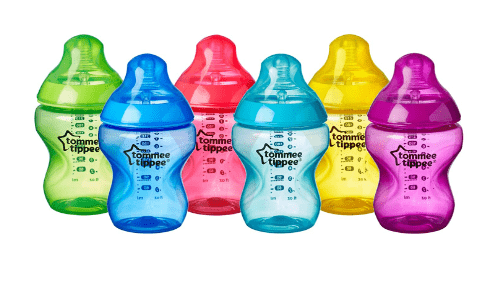Parenting can be an overwhelming experience at the best of times – and twins will, quite literally, double that experience. It’s normal to look for ways to ease your workload, and having your twins share a bottle seems like a natural choice. Can twins safely share a feeding bottle, though?
Having your twins share bottles is strongly discouraged, as making a habit of this will increase the risk of passing germs and infections between the two of them. Mixing up bottles once or twice won’t be the end of the world though, so don’t panic.
It’s pretty easy to mix them up, so figure out ways to differentiate bottles between twins. We’d recommend some form of labeling, color-coding, or even engravings for this purpose.
Bottle-sharing is unsafe, even between twins – even if you sterilize the bottle between uses. It would be safer to dedicate bottle sets for each twin to negate cross-contamination risk.
Why Can’t Twins Share Baby Bottles Safely?
The Danger of Sharing
It’s best for each baby to have their own set of bottles. This is especially important for infants, as their immune systems are quite sensitive and still developing. The same goes for pacifiers too.
This will be the case even if you sanitize the bottle between uses. Twins may look and even sound alike, but their immune systems – and their respective strength – will be completely different.
One twin might be completely unaffected by a pathogen, while the other could pick up a severe infection from the same specimen. A shared bottle potentially facilitates this exchange, and it’s always better to be safe than sorry when it comes to preparing your baby against sicknesses.
Common diseases

Sharing bottles increases the risk of illnesses – especially ones transmitted through saliva. This includes the flu, strep throat, mumps, and of course the common cold. In rare cases, sharing bottles between twins may also pass along skin or eye infections.
Other considerations
Even if you only have one baby, it’s unlikely that you’ve only got one feeding bottle on hand. Baby bottles can often be bought in sets, and having more on rotation makes feeding your infant a more manageable affair.
Having your twins share bottles is already a risky idea, but expecting them to share a single bottle will be impractical in the long run. You would only be able to feed one of them at any given time and would have to frantically sanitize said lone bottle between uses.
Try to have at least three bottles per infant on hand. You can get by with two, but having a third gives you a very welcome buffer – reducing the need to sanitize every bottle immediately after feeding. Since you’re handling twins, we’d personally recommend you pick up six bottles for use.
Marking Bottles

To prevent mix-up mishaps – especially with multiple bottles – it’s better to mark them down for easy differentiation. Below are a few quick and reliable ways to mark your twin’s bottles.
- Permanent marker – scribble their name on the bottle itself.
- Color-coded caps, rings, or bottles – relatively accessible on initial purchase.
- Stickers or Printed labels – fun and cute, but probably won’t last past one wash cycle.
- Engravings – a little pricy, though they’ll last for as long as the bottle will.
Marking bottles isn’t all that different from labeling pacifiers, honestly.
As a bonus, following these guidelines will also minimize the risk of other people mixing them up too, making them safe to ship off when your child is ready for their first time in a daycare center.
What About Reusing Old Bottles in Storage?
The key point here is that twins can’t share bottles due to cross-contamination risk, but what about using old bottles your other kids outgrow?
The bottles are just being passed along, rather than shared. They should be fit to reuse after thorough sanitation – so long as the plastic hasn’t warped, cracked, or clouded.
The same won’t extend to the bottle’s teat though – always replace that, even if it still looks serviceable at a glance! Even if you know it’s only been barely used too!
Final Thoughts
It’s not a good idea to have twins share feeding bottles – and it’d be a horrible idea to only have one bottle to split between two kids! Having a set of bottles on hand is a much more practical choice, and will save you a huge headache in both cleaning and maintenance in the long run.
Label all their bottles beforehand – through your method of choice – to minimize any potential mix-ups. Mixing up your twins’ bottles won’t usually be an immediate problem, but for the sake of your children’s health don’t make it a habit of letting this happen.